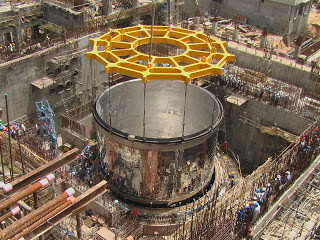Hindustan Times – India plans to commission the first-of-its-kind Prototype Fast Breeder Reactor (PFBR) early in 2013, kickstarting the second stage of its nuclear programme. The 500 MWe reactor, being developed by the Indira Gandhi Centre for Atomic Research (IGCAR) at Kalpakkam in Tamil Nadu, uses a Composeunique mix of uranium and plutonium which significantly enhances the capability to generate electricity per tonne of fuel utilised.
“The construction will be completed by September and fuel will be lowered by December, 2012. We expect commissioning by early 2013,” IGCAR Director S C Chetal said here.
India plans to have at least five more 500 MW fast breeder reactors by 2020, two of which could be set up at Kalpakkam.
Bharat Defence Kavach coverage
The state-of-the-art PFBR has inbuilt safety features and an array of sensors to detect any minuscule leak of sodium, which may prove hazardous, he said.
IGCAR has been successfully running a 13MW Fast Breeder Test Reactor for the last 27 years and it has been a test bed for new technologies developed at the research facility.
Last year, the life of the FBTR was extended by about another 20 years upto 2030 at 50 per cent operational capacity.
A fast reactor fuel cycle (FRFC), also being set up in Kalpakkam for the reprocessing of spent fuel from fast breeder reactors, is expected to be commissioned by 2016.
On the external front, a unique structural wall has also been erected around the area and the adjoining Kalpakkam township as a measure to protect against a possible tsunami.
The wall can withstand tsunami 50 per cent stronger than the one that hit the Tamil Nadu coast on December 26, 2004.
India is pursuing a three-stage nuclear power programme with a closed fuel cycle, which includes pressurised heavy water reactors, breeder reactors and advanced reactors.
The breeder reactors will use the spent fuel of heavy water reactors as fuel, while the advanced reactors will be fuelled by thorium.
Other Fast Reactors Under Construction, Design or Operating
Wikipedia list of fast neutron reactors
BN-600, 1981, Russia, 600 MWe, scheduled end of life 2010 but still in operation.
FBTR, 1985, India, 10.5 MWt
China Experimental Fast Reactor, 65 MWt, planned 2009, critical 2010
Jōyō (常陽?), 1977–1997 and 2003-, Japan
Monju reactor, 300MWe, in Japan. was closed in 1995 following a serious sodium leak and fire. It was restarted May 6, 2010
Under construction
PFBR, Kalpakkam, India, 500 MWe. Planned to open 2011
BN-800, Russia, planned operation in 2014
The Beloyarsk-4 BN-800 fast reactor has been delayed by lack of funds since construction start in 2006 and is now expected on line in 2014 after first criticality in September 2013.
It is represented as the first Generation III reactor which, after 2020, will start to take a large share of Russian capacity as Gen II designs are phased out, and fast reactors are projected as comprising some 14 GWe by 2030 and 34 GWe of capacity by 2050.
This first unit now seems to have adequate funding, though (as of January 2012) it is not due to start up until 2014 and be operational in 2015 due to earlier delays in equipment supplies. Construction is expected to be finished in 2012, when testing and commissioning will begin, with first criticality in September 2014. Initial fuel will be uranium (about 75%) plus 100 vibropacked MOX assemblies and 66 pelletised MOX ones (of 565 total). It will change over to full pelletised MOX fuel when the production line for it at MCC at Zheleznogorsk is operational and the fuel tested
Two BN-800 have been ordered by China. A high-level agreement was signed in October 2009, and an intergovernmental agreement relating to them is expected in 2012, to enable 2013 construction start.
OKBM Afrikantov in Zarechny is developing a BN-1200 reactor, and the design is expected to be complete by 2017, partly funded by federal nuclear technology program. SPb AEP also claims design involvement. It is intended to be a Generation IV design and produce electricity at RUR 0.65/kWh (US 2.23 cents/kWh), and Rosenergoatom is ready to involve foreign specialists in its design, with India and China particularly mentioned. Rosatom’s Science and Technology Council has approved the BN-1200 reactor for Beloyarsk, possibly to be operational about 2020. The Chelyabinsk regional government has reported that three BN-1200s are to be built at South Urals plant, but this is unconfirmed.
Moving in the other direction, and downsizing from BN-800 etc, a pilot 100 MWe SVBR-100 unit is to be built at RIIAR Dimitrovgrad by AKME-Engineering by about 2020. This is a modular lead-bismuth cooled fast neutron reactor concept from OKB Gidropress, and is designed to meet regional needs in Russia and abroad.
In design phase
BN-1200, Russia, build starting in 2012, operation in 2018-2020
Toshiba 4S being developed in Japan and is planned to be shipped to Galena, Alaska (USA) in 2012 (see Galena Nuclear Power Plant)
KALIMER, 600 MWe, South Korea, projected 2030
Generation IV reactor (Gas·Sodium·Lead cooled) US-proposed international effort, after 2030
JSFR, Japan, project for a 1500 MWe reactor begin in 1998->2010
ASTRID, France, project for a 600 MWe sodium-cooled reactor. Planned experimental operation in 2020
If you liked this article, please give it a quick review on ycombinator or StumbleUpon. Thanks

Brian Wang is a Futurist Thought Leader and a popular Science blogger with 1 million readers per month. His blog Nextbigfuture.com is ranked #1 Science News Blog. It covers many disruptive technology and trends including Space, Robotics, Artificial Intelligence, Medicine, Anti-aging Biotechnology, and Nanotechnology.
Known for identifying cutting edge technologies, he is currently a Co-Founder of a startup and fundraiser for high potential early-stage companies. He is the Head of Research for Allocations for deep technology investments and an Angel Investor at Space Angels.
A frequent speaker at corporations, he has been a TEDx speaker, a Singularity University speaker and guest at numerous interviews for radio and podcasts. He is open to public speaking and advising engagements.


